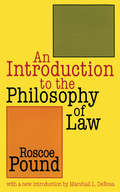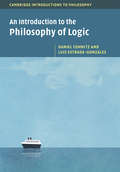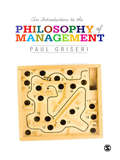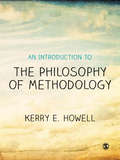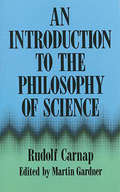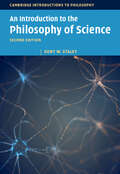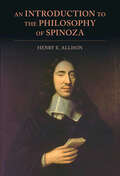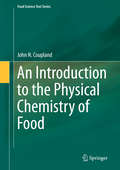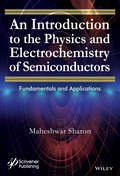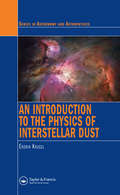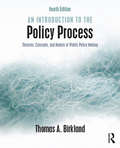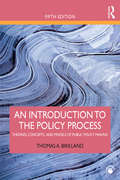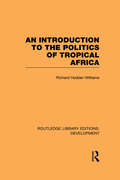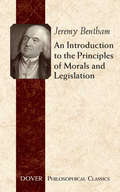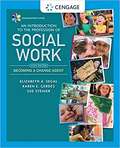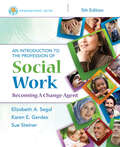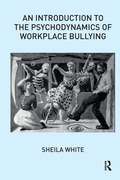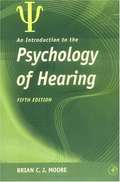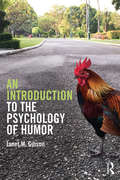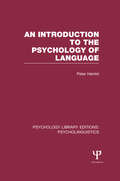- Table View
- List View
An Introduction to the Philosophy of Law (Storrs Lecture)
by Roscoe Pound Marshall. L DeRosaIn An Introduction to the Philosophy of Law, Roscoe Pound shows how philosophy has been a powerful instrument throughout the history of law. He examines what philosophy has done for some of the chief problems of the science of law and how it is possible to look at those problems philosophically without treating them in terms of a particular time period. The function of legal philosophy, writes Pound, is to rationally formulate a general theory of law which conforms to the interests, the general security first and foremost, of society. Marshall DeRosa writes in his new introduction that in the light of twentieth-century judicial politics, Roscoe Pound's philosophy of law has prevailed to a significant extent. This book's relevance to appreciating the development of the American legal system in all its complexities - including liability law, contract law, and property law - is in itself notable. But, in terms of understanding the twentieth-century development of the American rule of law, An Introduction to the Philosophy of Law is indispensable. It will make an invaluable addition to the personal libraries of legal theorists, philosophers, political scientists, and historians of American law.
An Introduction to the Philosophy of Logic (Cambridge Introductions to Philosophy)
by Daniel Cohnitz Luis Estrada-GonzálezPhilosophy of logic is a fundamental part of philosophical study, and one which is increasingly recognized as being immensely important in relation to many issues in metaphysics, metametaphysics, epistemology, philosophy of mathematics, and philosophy of language. This textbook provides a comprehensive and accessible introduction to topics including the objectivity of logical inference rules and its relevance in discussions of epistemological relativism, the revived interest in logical pluralism, the question of logic's metaphysical neutrality, and the demarcation between logic and mathematics. Chapters in the book cover the state of the art in contemporary philosophy of logic, and allow students to understand the philosophical relevance of these debates without having to contend with complex technical arguments. This will be a major new resource for students working on logic, as well as for readers seeking a better understanding of philosophy of logic in its wider context.
An Introduction to the Philosophy of Management
by Paul GriseriWhat and who is business for? What exactly is work and how can we distinguish it from other activity? Do businesses operate along different ethical lines from individuals?<P><P> This clear and accessible text introduces key philosophical concepts and ideas and applies them to fundamental issues in management and organizations. Written for business and management students with no previous knowledge of philosophy, this text will lead readers to question the basic assumptions widely made about business and management. <P> An Introduction to the Philosophy of Management is packed with case studies and examples which provoke thought and discussion. Coverage includes crucial topics such as business ethics, culture and leadership. <P> Key features: <P> - Boxed definitions of key concepts<P> - Real life case studies and examples<P> - Questions for Reflection<P> - Further reading<P> This text is essential reading for any business and management student wanting to think creatively.
An Introduction to the Philosophy of Mathematics
by Mark ColyvanThis introduction to the philosophy of mathematics focuses on contemporary debates in an important and central area of philosophy. The reader is taken on a fascinating and entertaining journey through some intriguing mathematical and philosophical territory, including such topics as the realism/anti-realism debate in mathematics, mathematical explanation, the limits of mathematics, the significance of mathematical notation, inconsistent mathematics and the applications of mathematics. Each chapter has a number of discussion questions and recommended further reading from both the contemporary literature and older sources. Very little mathematical background is assumed and all of the mathematics encountered is clearly introduced and explained using a wide variety of examples. The book is suitable for an undergraduate course in philosophy of mathematics and, more widely, for anyone interested in philosophy and mathematics.
An Introduction to the Philosophy of Methodology
by Kerry E HowellThis book provides students with a concise introduction to the philosophy of methodology. The book stands apart from existing methodology texts by clarifying in a student-friendly and engaging way distinctions between philosophical positions, paradigms of inquiry, methodology and methods. Building an understanding of the relationships and distinctions between philosophical positions and paradigms is an essential part of the research process and integral to deploying the methodology and methods best suited for a research project, thesis or dissertation. Aided throughout by definition boxes, examples and exercises for students, the book covers topics such as: - Positivism and Post-positivism - Phenomenology - Critical Theory - Constructivism and Participatory Paradigms - Post-Modernism and Post-Structuralism - Ethnography - Grounded Theory - Hermeneutics - Foucault and Discourse This text is aimed at final-year undergraduates and post-graduate research students. For more experienced researchers developing mixed methodological approaches, it can provide a greater understanding of underlying issues relating to unfamiliar techniques.
An Introduction to the Philosophy of Psychology
by Fred Adams Daniel A. WeiskopfPsychology aims to give us a scientific account of how the mind works. But what does it mean to have a science of the mental, and what sort of picture of the mind emerges from our best psychological theories? This book addresses these philosophical puzzles in a way that is accessible to readers with little or no background in psychology or neuroscience. Using clear and detailed case studies and drawing on up-to-date empirical research, it examines perception and action, the link between attention and consciousness, the modularity of mind, how we understand other minds, and the influence of language on thought, as well as the relationship between mind, brain, body, and world. The result is an integrated and comprehensive overview of much of the architecture of the mind, which will be valuable for both students and specialists in philosophy, psychology, and cognitive science.
An Introduction to the Philosophy of Religion
by Michael J. Murray Michael C. ReaAn Introduction to the Philosophy of Religion provides a broad overview of the topics which are at the forefront of discussion in contemporary philosophy of religion. Prominent views and arguments from both historical and contemporary authors are discussed and analyzed. The book treats all of the central topics in the field, including the coherence of the divine attributes, theistic and atheistic arguments, faith and reason, religion and ethics, miracles, human freedom and divine providence, science and religion, and immortality. In addition it addresses topics of significant importance that similar books often ignore, including the argument for atheism from hiddenness, the coherence of the doctrines of the Trinity and the Incarnation, and the relationship between religion and politics. It will be a valuable accompaniment to undergraduate and introductory graduate-level courses.
An Introduction to the Philosophy of Religion (Third Edition)
by Brian Davies<p>The third edition of An Introduction to the Philosophy of Religion provides a critical examination of some fundamental questions posed by religious belief: What does belief in God amount to? Can God's existence be proved? Is there life after death? <p>Brian Davies considers these questions and many others, sometimes offering provocative answers of his own, but more often giving readers room to each independent conclusions. He explains how a range of thinkers have approached the subject -- including Anselm, Aquinas, Descartes, Leibniz, Hume, and Kant -- and also discusses how contemporary author now engage with the issues involved. Completely revised to cover the latest developments in the field, the new edition of this established textbook will prove the ideal introduction for all students of the philosophy of religion.</p>
An Introduction to the Philosophy of Science
by Kent W. StaleyThis book guides readers by gradual steps through the central concepts and debates in the philosophy of science. Using concrete examples from the history of science, Kent W. Staley shows how seemingly abstract philosophical issues are relevant to important aspects of scientific practice. Structured in two parts, the book first tackles the central concepts of the philosophy of science, such as the problem of induction, falsificationism, and underdetermination, and important figures and movements, such as the logical empiricists, Thomas Kuhn, and Paul Feyerabend. The second part turns to contemporary debates in the philosophy of science, such as scientific realism, explanation, the role of values in science, the different views of scientific inference, and probability. This broad yet detailed overview will give readers a strong grounding whilst also providing opportunities for further exploration. It will be of particular interest to students of philosophy, the philosophy of science, and science.
An Introduction to the Philosophy of Science
by Rudolf CarnapOne of the most creative philosophers of the 20th century, Rudolf Carnap presented a series of science lectures at the University of California in 1958. The present volume is an outgrowth of that seminar, which dealt with the philosophical foundations of physics. Edited by Martin Gardner from transcripts of Carnap's classroom lectures and discussions, the book remains one of the clearest and soundest introductions to the philosophy of science.Specially designed to appeal to a wide range of readers, An Introduction to the Philosophy of Science offers accessible coverage of such topics as laws and probability, measurement and quantitative language, the structure of space, causality and determinism, theoretical laws and concepts and much more. Stimulating and thought-provoking, the text will be of interest to philosophers, scientists and anyone interested in logical analysis of the concepts, statements and theories of science. Foreword to the Basic Books Paperback Edition, 1974 (Gardner); Preface (Carnap); Foreword to the Dover Edition (Gardner). 35 black-and-white illustrations. Bibliography.
An Introduction to the Philosophy of Science (Cambridge Introductions to Philosophy)
by Kent W. StaleyThis thoroughly updated second edition guides readers through the central concepts and debates in the philosophy of science. Using concrete examples from the history of science, Kent W. Staley addresses questions about what science is, why it is important, and the basis for trust in scientific results. The first part of the book introduces the central concepts of philosophy of science, with updated discussions of the problem of induction, underdetermination, rationality, scientific progress, and important movements such as falsificationism, logical empiricism, and postpositivism, together with a new chapter on social constructionism. The second part offers updated chapters on probability, scientific realism, explanation, and values in science, along with new discussions of the role of models in science, science in policy-making, and feminist philosophy of science. This broad yet detailed overview will give readers a strong grounding in philosophy of science whilst also providing opportunities for further exploration.
An Introduction to the Philosophy of Spinoza
by Henry E. AllisonAimed at those new to studying Spinoza, this book provides a comprehensive introduction to his thought, placing it in its historical and philosophical contexts, and assessing its critical reception. In addition to providing an analysis of Spinoza's metaphysical, epistemological, psychological, and ethical views in the Ethics, Henry Allison also explores his political theory and revolutionary views on the Bible, as well as his account of Judaism, which led to the excommunication of the young Spinoza from the Jewish community in Amsterdam. Although the book's main focus is on the analysis of Spinoza's views, including a close reading of the central arguments of the Ethics, it also considers many of the standard objections to these arguments as well as possible responses to them. This completely revised and updated new edition of Allison's classic book, with two new chapters, will help a new generation of students to understand and value Spinoza's work.
An Introduction to the Physical Chemistry of Food (Food Science Text Series)
by John N. CouplandFamiliar combinations of ingredients and processing make the structures that give food its properties. For example in ice cream, the emulsifiers and proteins stabilize partly crystalline milk fat as an emulsion, freezing (crystallization) of some of the water gives the product its hardness and polysaccharide stabilizers keep it smooth. Why different recipes work as they do is largely governed by the rules of physical chemistry. This textbook introduces the physical chemistry essential to understanding the behavior of foods. Starting with the simplest model of molecules attracting and repelling one another while being moved by the randomizing effect of heat, the laws of thermodynamics are used to derive important properties of foods such as flavor binding and water activity. Most foods contain multiple phases and the same molecular model is used to understand phase diagrams, phase separation and the properties of surfaces. The remaining chapters focus on the formation and properties of specific structures in foods - crystals, polymers, dispersions and gels. Only a basic understanding of food science is needed, and no mathematics or chemistry beyond the introductory college courses is required. At all stages, examples from the primary literature are used to illustrate the text and to highlight the practical applications of physical chemistry in food science.
An Introduction to the Physics and Electrochemistry of Semiconductors: Fundamentals and Applications
by Maheshwar SharonThis book has been designed as a result of the author's teaching experiences; students in the courses came from various disciplines and it was very difficult to prescribe a suitable textbook, not because there are no books on these topics, but because they are either too exhaustive or very elementary. This book, therefore, includes only relevant topics in the fundamentals of the physics of semiconductors and of electrochemistry needed for understanding the intricacy of the subject of photovoltaic solar cells and photoelectrochemical (PEC) solar cells. The book provides the basic concepts of semiconductors, p:n junctions, PEC solar cells, electrochemistry of semiconductors, and photochromism. Researchers, engineers and students engaged in researching/teaching PEC cells or knowledge of our sun, its energy, and its distribution to the earth will find essential topics such as the physics of semiconductors, the electrochemistry of semiconductors, p:n junctions, Schottky junctions, the concept of Fermi energy, and photochromism and its industrial applications. "The topics in this book are explained with clear illustration and indispensable terminology. It covers both fundamental and advanced topics in photoelectrochemistry and I believe that the content presented in this monograph will be a resource in the development of both academic and industrial research". Professor Akira Fujishima, President, Tokyo University of Science, and Director, Photocatalysis International Research Center, Tokyo University of Science, Japan
An Introduction to the Physics of Interstellar Dust
by Endrik KrugelStreamlining the extensive information from the original, highly acclaimed monograph, this new An Introduction to the Physics of Interstellar Dust provides a concise reference and overview of interstellar dust and the interstellar medium. Drawn from a graduate course taught by the author, a highly regarded figure in the field, this all-in-one book
An Introduction to the Policy Process
by Thomas A BirklandThe fourth edition of this widely-used text relates theory to practice in the public policy process. In a clear, conversational style, author Tom Birkland conveys the best current thinking on the policy process with an emphasis on accessibility and synthesis. This new edition has been reorganized to better explain the role of policy analysis in the policy process. New to this edition: * A new section on the role of policy analysis and policy analysts in the policy process. * A revised and updated chapter surveying the social, economic, and demographic trends that are transforming the policy environment. * Fully updated references to help the advanced reader locate the most important theoretical literature in policy process studies. * New illustrations and an improved layout to clarify key ideas and stimulate classroom discussion. The book makes generous use of visual aids and examples that link policy theory to the concrete experience of practitioners. It includes chapter-at-a-glance outlines, definitions of key terms, provocative review questions, recommended reading, and online materials for professors and students.
An Introduction to the Policy Process: Theories, Concepts, and Models of Public Policy Making
by Thomas A. BirklandNow in a thoroughly revised Fifth Edition, An Introduction to the Policy Process provides students at all levels with an accessible, readable, and affordable introduction to the field of public policy. In keeping with prior editions, author Tom Birkland conveys the best current thinking on the policy process in a clear, conversational style. Designed to address new developments in both policy theory and policy making, the Fifth Edition includes examinations of: the Brexit referendum result and its effects on the UK, European Union, and world politics, as well as the 2016 election of Donald Trump as President of the United States, and the ways in which these events have caused voters and policy makers to rethink their assumptions; changes to the media environment, including the decline of newspapers and television news, the growth of social media, and the emergence of "fake news"; new policy theory developments like the emergence of the Narrative Policy Framework and continued and newer applications of existing theories of policy process like Advocacy Coalitions, Multiple Streams, Punctuated Equilibrium, and Institutional Analysis and Development; and all-new and updated chapter "at a glance" outlines, definitions of key terms, provocative review questions, recommended reading, visual aids and case studies, theoretical literature, and preentation slides and Test Banks to make teaching from the book easier than ever. Firmly grounded in both social science and political science, An Introduction to the Policy Process provides the most up-to-date and thorough overview of the theory and practice of the policy process, ideal for upper-level undergraduate and introductory graduate courses in Public Policy, Public Administration, and Political Science programs.
An Introduction to the Politics of Tropical Africa (Routledge Library Editions: Development)
by Richard Hodder-WilliamsThis wide-ranging and informative introduction to politics in tropical Africa, first published in 1984, is essential reading to students, businessmen, government officials and economic advisers alike. Situating the contemporary scene firmly in its historical context, which stresses both pre-colonial and colonial heritages, he emphasizes how politicians are constrained by the past, the physical environment and the world’s economy, yet still retain freedom of choice on a wide range of issues. The book is thematically organised and provides both an overview of the general similarities of the continent and also enough detail to flesh out the realities of tribalism and corruption, as well as illustrating the variations that inevitably occur in a continent of sovereign states.
An Introduction to the Principles of Morals and Legislation (Barnes And Noble Library Of Essential Reading)
by Jeremy BenthamFirst published in 1789, Jeremy Bentham's best-known work remains a classic of modern philosophy and jurisprudence. Its definitions of the foundations of utilitarian philosophy and its groundbreaking studies of crime and punishment retain their relevance to modern issues of moral and political philosophy, economics, and legal theory.Based on the assumption that individuals seek pleasure and avoid pain, Bentham's utilitarian perspective forms a guide to moral decision-making. With the "greatest happiness of the greatest number" as his objective, the author attempts to identify the sources and varieties of pleasure and pain as well as the ways in which they can be measured in assessing moral options. Considerations of intentionality, consciousness, motives, and dispositions support Bentham's arguments. The text concludes with his survey of purpose and the role of law and jurisprudence, a fascinating exercise in the theory of social reform that explores conflicts between the interests of the majority and individual freedom.
An Introduction to the Profession of Social Work (Empowerment Series)
by Elizabeth A. Segal Sue Steiner Karen E. GerdesWhat does it mean to be a social worker? Get an overview of the social work profession and learn about the role of the social worker in the social welfare system with Segal, Gerdes and Steiner's text. <p><p> Through case studies, personal stories and exercises, AN INTRODUCTION TO THE PROFESSION OF SOCIAL WORK helps you apply concepts as well as understand what social workers do, what they need to know and the issues they face. Part of the Brooks/Cole Empowerment Series, the sixth edition is completely up to date. It also prepares you for a successful career by integrating the core competencies and recommended practice behaviors outlined in the most recent Educational Policy and Accreditation Standards (EPAS) set by the Council on Social Work Education (CSWE).
An Introduction to the Profession of Social Work: Becoming A Change Agent (Empowerment Series)
by Elizabeth A. Segal Sue Steiner Karen E. GerdesSegal, Gerdes, and Steiner's AN INTRODUCTION TO THE PROFESSION OF SOCIAL WORK introduces readers to the social work profession and describes the role of social worker in the social welfare system. Through case studies, personal stories, and exercises, this social work text helps readers apply the concepts and truly understand what it means to be a social worker. Part of the Brooks/Cole Empowerment Series, the fourth edition is completely up to date and thoroughly integrates the core competencies and recommended practice behaviors outlined in the most recent Educational Policy and Accreditation Standards (EPAS) set by the Council on Social Work Education (CSWE).
An Introduction to the Psychodynamics of Workplace Bullying
by Sheila WhiteThis book gives in-depth insights into the core issues of workplace bullying from the perspectives of the individuals involved, their interpersonal relationships, the group dynamics and organisational contexts. Workplace bullying is costly: increasingly petty conflicts are being registered as formal complaints and, in no time, legalities take over and costs spiral out of control. Preventive actions and interventions need to be based on a sound knowledge of the deeper issues which foster bullying scenarios. This book gets to the roots of why and how bullying occurs. Four main chapters are devoted to individuals, interpersonal relationships, group dynamics, and organisational contexts. The fifth chapter is a case study of the 'turn round' of a workplace in which bullying was rife. There are three recurring themes: recognition, loss, and space. New ways of conceptualising bullying are presented from drawing on the literature on the subject, as well as a range of psychodynamics theories. Bullying is described as a perverse and pernicious form of projective identification, occurring around organisational vacuums and structural fractures.
An Introduction to the Psychology of Hearing
by Brian C. J. MooreNow available in a Fifth Edition, An Introduction to the Psychology of Hearing is the leading textbook in the field of auditory perceptionalso known as psychoacoustics. The Fifth Edition has been thoroughly updated, with more than 200 references to articles and books published since 1996. <P><P>The book describes the relationships between the characteristics of the sounds that enter the ear and the sensations that they produce. Wherever possible these relationships are specified in terms of the underlying mechanisms. In other words, the goal is to impart an understanding of what the auditory system does and how it works. <P><P>Topics covered include the physics of sound, the physiology of the auditory system, frequency selectivity and masking, loudness perception, temporal analysis, pitch perception, sound localization, timbre perception, the perceptual organization of complex auditory "scenes", speech perception, and practical applications such as hearing aids, cochlear implants, and high-fidelity sound reproduction. <P><P>The book starts from basic principles, and does not assume prior knowledge about hearing. Research results are not just described, but are interpreted and evaluated. The book includes extensive references to recent research so that those interested in a specific area can readily obtain more detailed information.
An Introduction to the Psychology of Humor
by Janet M. GibsonAn Introduction to the Psychology of Humor provides a comprehensive and accessible overview of psychologists’ research on humor. Drawing on research from a variety of psychological perspectives, from cognitive and biological to social and developmental, the book explores factors that affect our detection, comprehension, liking, and use of humor. Throughout the book, theories and paradigms of humor are explored, with each chapter dedicated to a distinct field of psychological research. Covering topics including humor development in children and older adults, humor’s effectiveness in advertisements, cross-cultural psychology and humor’s functions in the workplace, the book addresses the challenges psychologists face in defining and studying humor despite it being a universal and often daily experience. Featuring a wealth of student-friendly features, including learning objectives and classroom activities, An Introduction to the Psychology of Humor is an essential read for all students of humor.
An Introduction to the Psychology of Language (Psychology Library Editions: Psycholinguistics)
by Peter HerriotOriginally published in 1970, this was Peter Herriot’s first book. In this objective, critical evaluation of a rapidly expanding field, Professor Herriot examines language as skilled behaviour, generative linguistics and psychology, behaviourist approaches to meaning, language acquisition and impairment, and language and thought. He stresses throughout the necessity for empirical research and for experimental verification of hypotheses; he also feels that language behaviour should be analysed in a comprehensive form, placing emphasis not only on structural aspects but also on the importance of meaning and context to any account of language. Today it can be read and enjoyed in its historical context.
